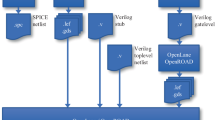Abstract
In this paper, a low power technique, called SBR (Sign Bit Reduction), which reduces the energy consumption in multipliers as well as data buses is proposed. The technique reduces the number of sign bits in the data transfer as well as in the multiplication process. This feature enables us to use the encoding technique for both the transfer of the data and its multiplication at the destination without any need for an intermediate decoding step. Simple circuits are used as the SBR decoder and encoder. The efficacy of the technique is evaluated for both voice and random data. The results of applying the voice data to a 16-bit multiplier implemented with this scheme shows energy consumption up to 11.4% compared to those of a 2’s complement implementation, while the number of required clock periods for the multiplication process is reduced up to 14.5%. The results of applying the SBR technique to a 30-tap FIR filter show up to 9.6% reduction in the energy consumption and up to 13.4% reduction in the required clock cycles. Finally, for voice data and random inputs, the use of the technique for a 16-bit data bus leads to an average energy consumption of up to 14.6%.






Similar content being viewed by others
References
Erdogan, T., & Arslan, T. A coefficient segmentation algorithm for low power implementation of FIR filters. In Proceedings of the IEEE International Symposium on Circuit and System, 3, 30 May–2 June 1999, pp 359–362.
Zheng, M., & Albicki, A. Low power and high speed multiplication design through mixed number representations, In Proceedings of the International Conference on Computer Design, October 1995, Austin, Texas.
Yu, Z., Yu, M. L., Azadet, K., & Willson, A. N. (2002). The use of reduced two’s complement representation in low power DSP design. The IEEE International Symposium on Circuits and Systems (ISCAS’02), 1, I-77–I-80. May.
Aghaghiri, Y., Fallah, F., & Pedram, M., “ALBORZ: Address level bus power optimization,” In Proceeding of the International Symposium on Quality Electronic Design 2002 (ISQED’02).
Su, C. L., Tsui, C. Y., & Despain, A. M. Low power architecture design and compilation technique for high-performance processors. In Proceeding of IEEE COMPCON, San Francisco, CA, Feb. 1994, pp. 209–214.
Benini, L., De Micheli, G., Macii, E., Sciuto, D.,& Silvano, C. Asymptotic zero-transition activity encoding for address busses in low-power microprocessor-based systems. In Proceeding of IEEE 7th Great Lakes Symposium on VLSI, Mar. 1997, pp. 77–82.
Fornaciari, W., Polentarutti, M., Sciuto, D., & Silvano, C. Power optimization of system-level address buses based on software profiling. In Proceeding of CODES 2000, San Diego, CA, 2000, pp. 29–33.
Aghaghiri, Y., Fallah, F., & Pedram, M. Irredundant address bus encoding for low-power. In Proceeding of IEEE International Symposium on Low-Power Electronics and Design, Aug. 2001, pp. 182–187.
Musoll, E., Lang, T., & Cortadella, J. (1998). Working-zone encoding for reducing the energy in microprocessor address buses. IEEE Transaction on Very Large Scale Integrated (VLSI) system, 6, 568–572. Dec.
Mamidipaka, M., Hirschberg, D., & Dutt, N. Low power address encoding using self-organizing list. In Proceeding of IEEE International Symposium on Low-Power Electronics and Design, Aug. 2001, pp. 188–193.
Stan, M. R., & Burleson, W. P. (1995). Bus-invert coding for low-power I/O. IEEE Transaction on Very Large Scale Integrated (VLSI) system, 3(1), 49–58. March.
Stan, M. R., & Burleson, W. P. Limited-weight codes for low power I/O. In Proceeding of International Workshop on Low Power Design, Napa, CA, April 1994.
Shin, Y., Choi, K., & Chang, Y. H. (2001). Narrow bus encoding for low-power DSP systems. IEEE Transaction on Very Large Scale Integrated (VLSI) system, 9(5), 656–660. October.
Lin, R., & Tsai, C. (2002). Theoretical analysis of bus-invert coding. IEEE Transaction on Very Large Scale Integrated (VLSI) system, 10, 929–934. December.
Zhang, Y., Lach, J., Skadron, K., & Stan, M. R. Odd/even bus invert with two-phase transfer for busses with coupling. In Proceeding of IEEE International Symposium Low-Power Electronics and Design, 2002, pp. 754–757.
Petrov, P., & Orailoglu, A. (2004). Low-power instruction bus encoding for embedded processors. IEEE Transaction on Very Large Scale Integrated (VLSI) system, 12(8), 812–826. August.
Sotiriadis, P. P., Chandrakasan, A. P. (2003) Bus energy reduction by transition pattern coding using a detailed deep submicrometer bus model. IEEE Transactions on Circuits and Systems: Fundamental Theory and Applications, 50(10), October.
Parhami, B. (2000). Computer arithmetic: algorithms and hardware designs. Oxford: Oxford University Press.
Landman, P. E., & Rabaey, J. M. (1995). Architectural power analysis: the dual bit type method. IEEE Transaction on Very Large Scale Integrated (VLSI) system, 3(2), 173–187. June.
Im, S., Srivastava, N., Banerjee, K., & Goodson, K. E. (2005). Scaling analysis of multilevel interconnect temperatures for high-performance ICs. IEEE Transactions on Electron Devices, 52(12), 2710–2719. Dec.
Acknowledgements
MS and AAK wish to thank Iran Telecommunication Research Center for the financial support.
Author information
Authors and Affiliations
Corresponding author
Rights and permissions
About this article
Cite this article
Saneei, M., Afzali-Kusha, A. & Navabi, Z. Sign Bit Reduction Encoding For Low Power Applications. J Sign Process Syst Sign Image Video Technol 57, 321–329 (2009). https://doi.org/10.1007/s11265-008-0317-0
Received:
Revised:
Accepted:
Published:
Issue Date:
DOI: https://doi.org/10.1007/s11265-008-0317-0




